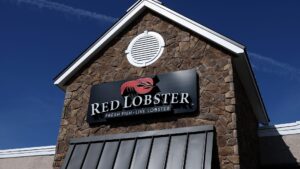Red Lobster Faces Chapter 11 Bankruptcy: What Went Wrong and What’s Next
In a surprising turn of events, Red Lobster has filed for Chapter 11 bankruptcy protection as the seafood chain continues its efforts to downsize and attract potential buyers. This news comes as a blow to the iconic restaurant brand, which has been struggling under the weight of significant debt and long-term leases.
According to CNBC, Red Lobster has a “stalking horse bid” from its existing lenders to buy the company, with the possibility of a higher bid coming in to snatch up the chain. The company recently appointed a new CEO, Jonathan Tibus, a restructuring expert from advisory firm Alvarez & Marsal, to lead the company through this challenging time.
In a court filing, Tibus cited a combination of factors that led to Red Lobster’s decision to file for Chapter 11 protection, including a tough macroeconomic environment, a large and underperforming restaurant footprint, failed strategic initiatives, and increased competition within the restaurant industry. The chain’s real estate portfolio has also been a major source of concern, with the company’s former owners, Golden Gate Capital, playing a role in creating this issue.
When Darden Restaurants sold Red Lobster to Golden Gate Capital in 2014, the deal was partially funded through a sale-leaseback agreement, which created financial strain on the chain. As a result, Red Lobster has been forced to close underperforming locations, cut down its real estate footprint, and seek relief from burdensome leases.
Red Lobster currently operates over 550 locations in the U.S. and Canada, with a significant number of employees working in part-time roles. The company’s assets and liabilities fall within the $1 billion to $10 billion range, according to the bankruptcy filing, with Performance Food Group being identified as its largest creditor.
Despite these challenges, Red Lobster remains optimistic about the future. In a statement, CEO Jonathan Tibus expressed confidence that the restructuring process will help the company address its financial and operational issues, allowing it to emerge stronger and more focused on growth. The support from lenders and vendors is seen as essential in ensuring a smooth sale process while prioritizing the well-being of employees and guests.
Founded in 1968 and acquired by General Mills in the early 1970s, Red Lobster has gone through several ownership changes over the years. Despite surviving the pandemic, the chain has faced declining revenues and changing consumer preferences, leading to its current financial woes.
As Red Lobster navigates this challenging period, the company is focused on streamlining its operations, strengthening its financial position, and charting a path towards sustainable growth. Stay tuned for updates on the latest developments as Red Lobster works to overcome its current challenges and reshape its future in the competitive restaurant industry.
For more exclusive insights and analysis on the latest business news, stay connected with Extreme Investor Network.

